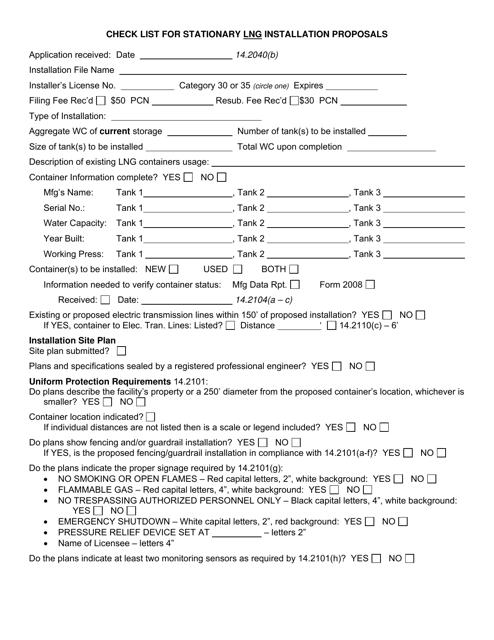Check List for Stationary Lng Installation Proposals - Texas
Check List for Stationary Lng Installation Proposals is a legal document that was released by the Railroad Commission of Texas - a government authority operating within Texas.
FAQ
Q: What is a stationary LNG installation?
A: A stationary LNG installation is a facility designed to store and distribute liquefied natural gas.
Q: Why would someone propose a stationary LNG installation?
A: Proposing a stationary LNG installation can provide a secure and reliable source of natural gas for a specific location or community.
Q: What factors should be considered when proposing a stationary LNG installation?
A: Factors to consider include the location, safety measures, environmental impact, regulatory requirements, and the cost of construction and operation.
Q: What are some safety measures that should be included in a stationary LNG installation proposal?
A: Safety measures may include fire and explosion prevention systems, emergency response plans, and ongoing monitoring and maintenance procedures.
Q: What are the environmental considerations for a stationary LNG installation?
A: Environmental considerations may include the potential for air and water pollution, the impact on wildlife and habitats, and adherence to environmental regulations.
Q: What regulatory requirements are involved in a stationary LNG installation proposal?
A: Regulatory requirements may include obtaining permits and approvals from federal, state, and local agencies, as well as compliance with industry standards and guidelines.
Q: What are the costs associated with constructing and operating a stationary LNG installation?
A: Costs may vary depending on the size and complexity of the facility, but can include land acquisition, equipment, infrastructure, labor, maintenance, and compliance expenses.
Form Details:
- The latest edition currently provided by the Railroad Commission of Texas;
- Ready to use and print;
- Easy to customize;
- Compatible with most PDF-viewing applications;
- Fill out the form in our online filing application.
Download a printable version of the form by clicking the link below or browse more documents and templates provided by the Railroad Commission of Texas.











